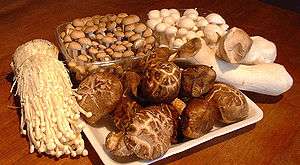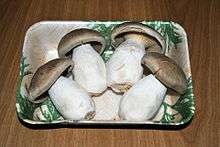Shimeji
Shimeji (Japanese:シメジ, 占地 or 湿地) is a group of edible mushrooms native to East Asia, but also found in northern Europe.[1] Hon-shimeji (Lyophyllum shimeji) is a mycorrhizal fungus and difficult to cultivate. Other species are saprotrophs, and buna-shimeji is now widely cultivated. Shimeji is rich in umami tasting compounds such as guanylic acid, glutamic acid, and aspartic acid.[2]


Species
Several species are sold as shimeji mushrooms. All are saprotroph except Lyophyllum shimeji.
- Mycorrhiza
- Hon-shimeji (ホンシメジ), Lyophyllum shimeji
- The cultivation methods have been patented by several groups, such as Takara Bio[3] and Yamasa,[4] and the cultivated hon-shimeji is available from several manufacturers in Japan.[5][6]
- Saprotroph
- Buna-shimeji (ブナシメジ, lit. beech shimeji), Hypsizygus tessellatus, also known in English as the brown beech or brown clamshell mushroom
- Hypsizygus marmoreus is a synonym of Hypsizygus tessellatus. Cultivation of Buna-shimeji was first patented by Takara Shuzo Co.,Ltd. in 1972 as hon-shimeji and the production started in 1973 in Japan.[7] Now, several breeds are widely cultivated and sold fresh in markets.
- Bunapi-shimeji (ブナピー), known in English as the white beech or white clamshell mushroom
- Bunapi was selected from UV-irradiated buna-shimeji ('hokuto #8' x 'hokuto #12') and the breed was registered as 'hokuto shiro #1' by Hokuto Corporation.[8][9]
- Hatake-shimeji (ハタケシメジ), Lyophyllum decastes
- Shirotamogidake (シロタモギダケ), Hypsizygus ulmarius
- These two species had been also sold as hon-shimeji.
- Velvet pioppino (alias velvet pioppini, black poplar mushroom, Chinese: 茶樹菇/茶树菇), Agrocybe aegerita
Cooking
Shimeji should always be cooked: it is not a good mushroom to serve raw due to a somewhat bitter taste, but the bitterness disappears completely upon cooking. The cooked mushroom has a pleasant, firm, slightly crunchy texture and a slightly nutty flavor. Cooking also makes this mushroom easier to digest. It works well in stir-fried foods, as well as with wild game or seafood. Also it can be used in soups, stews and in sauces. When cooked alone, Shimeji mushrooms can be sautéed whole, including the stem or stalk (only the very end cut off), using a higher temperature or they can be slow roasted on a low temperature with a small amount of butter or cooking oil. Shimeji is used in soups, nabe and takikomi gohan.
See also
References
| Wikimedia Commons has media related to Shimeji. |
- Hon Shimeji located in Sweden - http://www.spiegel.de/wissenschaft/natur/0,1518,703531,00.html (German) - retrieved June 30, 2010
- (in Japanese) Hyoeiオリジナルコラム(なでしこ通信) 日本人はキノコが大好き Archived 2007-12-13 at the Wayback Machine, Hyogo NCC College.
- METHOD FOR ARTIFICIALLY CULTURING LYOPHYLLUM SHIMEJI, TAKARA AGURI KK, JP2001120059. ARTIFICIAL CULTIVATION METHOD OF LYOPHYLLUM SHIMEJI, TAKARA BIO INC, JP2007143565.
- NEW STRAIN OF LYOPHYLLUM SHIMEJI AND USE OF THE SAME, YAMASA SHOYU KK, JP2006271234. METHOD FOR ARTIFICIALLY CULTURING LYOPHYLLUM SHIMEJI AND CULTURE MEDIUM, Yamasa Shoyu KK, JP2007054044.
- (in Japanese) 雪国本しめじ Archived 2007-12-15 at the Wayback Machine, Yukiguni Maitake Co.,Ltd.
- (in Japanese) ヤマサほんしめじ, Yamasa Corporation.
- (in Japanese) Hypsizigus marmoreus - 長期利用微生物参考データ(食品工業利用微生物), Ministry of Economy, Trade and Industry, Japan.
- Bunashimeji and Bunapi Archived 2007-12-16 at the Wayback Machine, Hokuto Corporation.
- (in Japanese) ホクト白1号菌 (第13294号), Plant Variety Protection, Ministry of Agriculture, Forestry and Fisheries (Japan).
External links
- Honshimeji Mushroom, RecipeTips.com. Brown Beech (Buna shimeji), White Beech (Bunapi shimeji), and the Pioppino (Agrocybe aegerita) mushrooms.